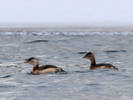search
classification
|
basic information
|
video
|
reports |
Little Grebe
Tachybaptus ruficollis (Pallas, 1764)

|
 adult summer subspecies poggei
|
|
|
2017-05-12
Buryatia. Selenginsky region, Gusinoe lake. |
© Valerii Bogdanovich
|
|
Description
The Little Grebe is a little bird slightly larger than Thrush. In breeding plumage the upperparts are black-brownish, flight feathers are brownish, and the secondaries are with large white spots; the lores and throat are black; the fore and sides of the top-neck are chestnut-rusty; underparts are grey-brownish, the middle-abdomen is slightly paler; the axillaries and underwing coverts are white. In winter the upperparts are brownish; the sides of head and neck and the fore-neck are dirty-buff; the throat, bottom-breast and abdomen are almost white slightly brownish tinged. Juveniles are similar on autumn adults; but generally paler, bottom-neck is almost without buffy tinge, abdomen is more whiter almost without brownish. In breeding plumage it is easy differenced by the absence of collar and crest, by the rusty cheeks and neck. In autumn plumage differenced from other Grebes by the generally buffy-rusty color. Weight 110-370 grams, length 25-29, wing 9,0-11,1, wingspan about 40 cm.<br>
Distribution
Vagrant in Siberia, in particular in the area of Lake Baikal (one of these birds definitely belongs to western group of subspecies). Data on breeding in Khakasia and Transbaikal are uncertain.<br>European and Central Asian subspecies (T.r.ruficollis and T.r.capensis, accordingly) have darker (brown) iris. Far Eastern subspecies (P.r.poggei and others) have lighter (pale yellow or white) iris in any age.//
Biology
The Little Grebe is common resident or short distant migrant. Inhabits mainly small reservoirs with standing or slow flowing water and plentiful vegetation (reed, cane, reed-mace). In Kazakhstan, appears at end February - early March. Breeding begins early May. Floating nests are built on water, among vegetation, from decayed reed leaves. Clutches usually 4-5, less often of 3 or 6 eggs in May. Juveniles have been noted up to the beginning of August. Dates of autumn migration are not known. Late birds have been seen end October. There were trials to stay winter in the Baikal region and near Krasnoyarsk.//
References
Gavrilov E. I., Gavrilov A. E. "The Birds of Kazakhstan". Almaty, 2005.
В.К.Рябицев. "Птицы Урала, Приуралья и Западной Сибири". Екатеринбург, Изд-во Уральского университета, 2000.
В.К.Рябицев. "Птицы Сибири". Москва-Екатеринбург, Изд-во "Кабинетный ученый", 2014.<br>















